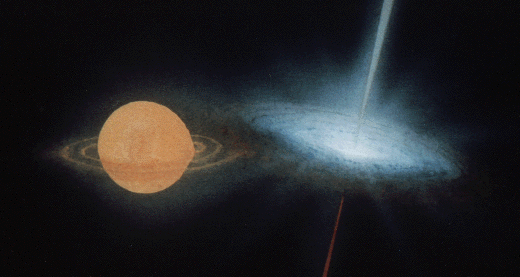Credit & Copyright: Artist's Visualization (NASA)
Explanation:
SS433
is one of the most exotic star systems known. Its unremarkable
name stems from its inclusion in a catalog of stars which emit
radiation characteristic of atomic hydrogen.
Its very remarkable behavior stems from a compact object, a black hole
or neutron star,
which has produced an accretion disk with jets. As illustrated
in this artist's vision
of the SS433 system
based on observational data,
a massive, hot star (left) is locked in a mutual orbit with a
compact object. Material transfers from the massive star into
an accretion disk surrounding the
compact object blasting out two jets of ionized gas in opposite
directions - at about 1/4 the speed of light!
Radiation from the jet tilted toward the observer is blueshifted,
while radiation from the jet tilted away is redshifted.
The binary system itself completes an orbit in about 13 days while
the jets precess (wobble like a top) with a period of about 164
days. Are the jets from SS433 related to those from black
holes at the centers of galaxies?
1999 2000 2001 2002 2003 2004 2005 2006 2007 2008 2009 2010 2011 2012 2013 2014 2015 2016 2017 2018 2019 2020 2021 2022 2023 2024 2025 |
Январь Февраль Март Апрель Май Июнь Июль Август Сентябрь Октябрь Ноябрь Декабрь |
NASA Web Site Statements, Warnings, and Disclaimers
NASA Official: Jay Norris. Specific rights apply.
A service of: LHEA at NASA / GSFC
& Michigan Tech. U.
|
Публикации с ключевыми словами:
SS433 - нейтронные звезды - черные дыры - аккреционный диск - джет - двойная система
Публикации со словами: SS433 - нейтронные звезды - черные дыры - аккреционный диск - джет - двойная система | |
См. также:
Все публикации на ту же тему >> | |
